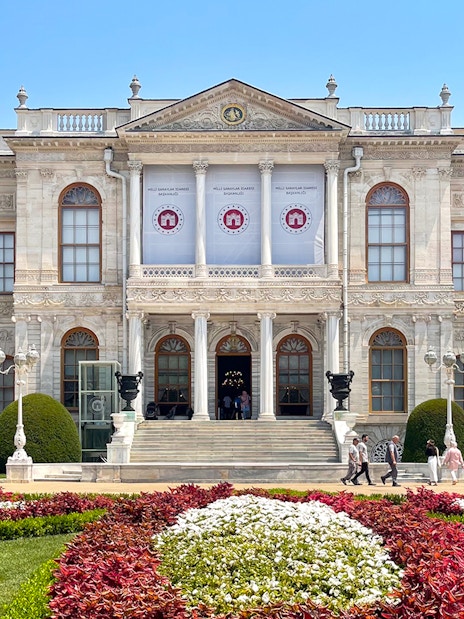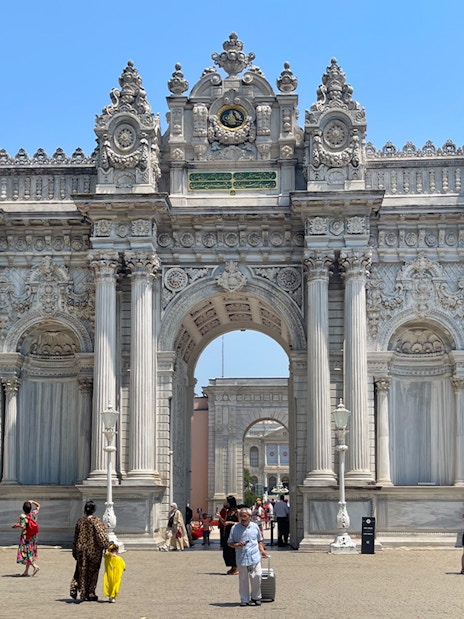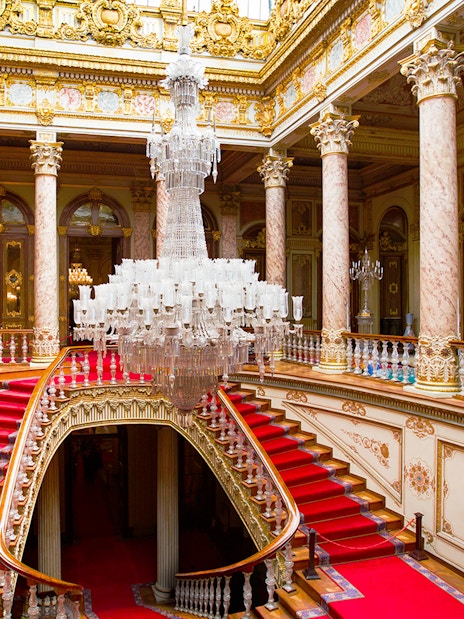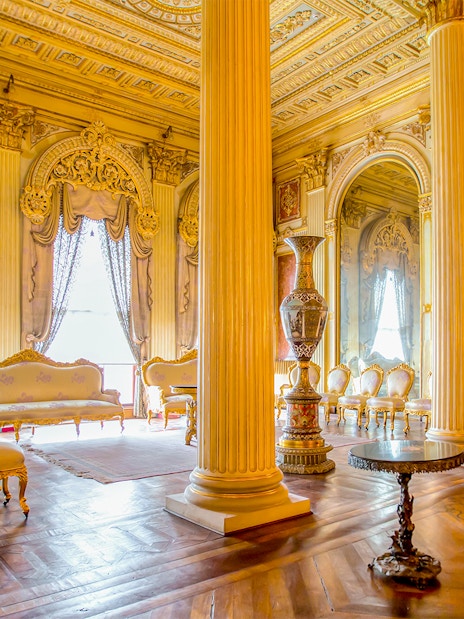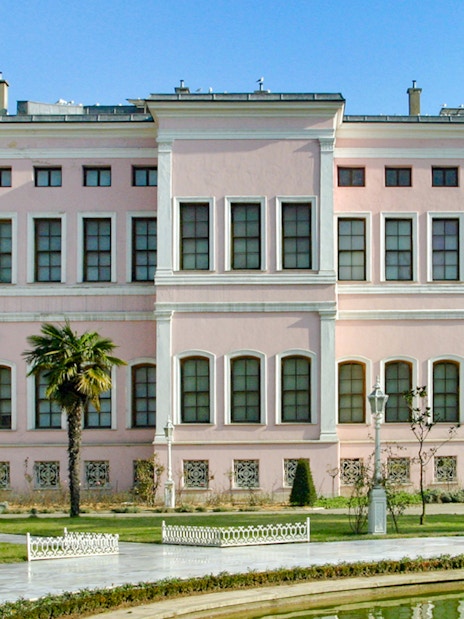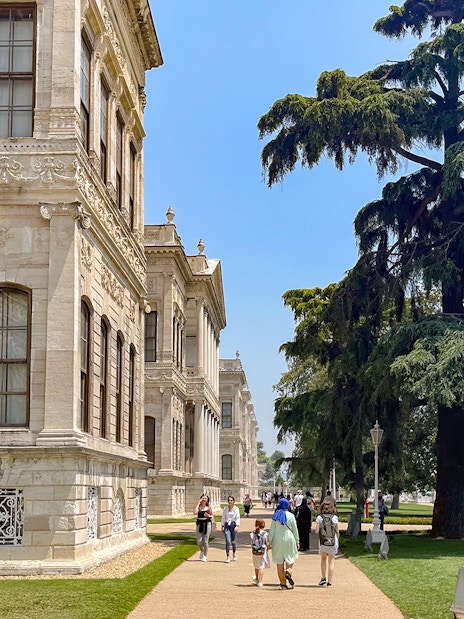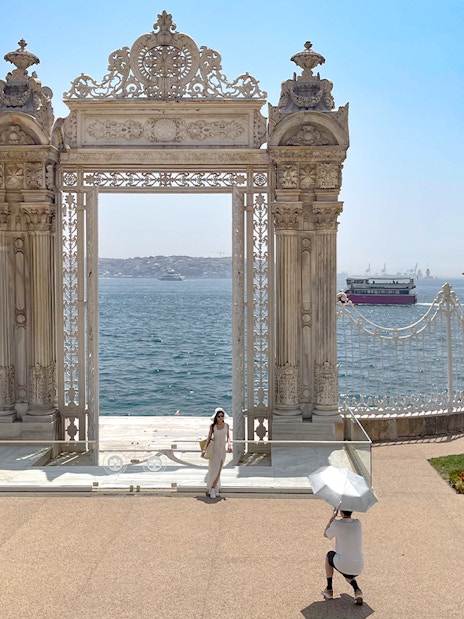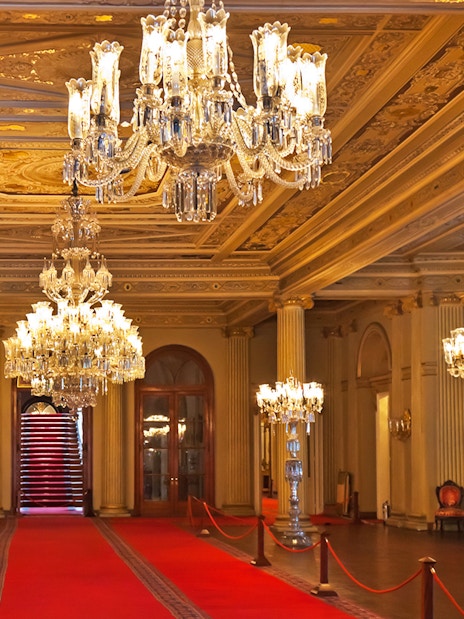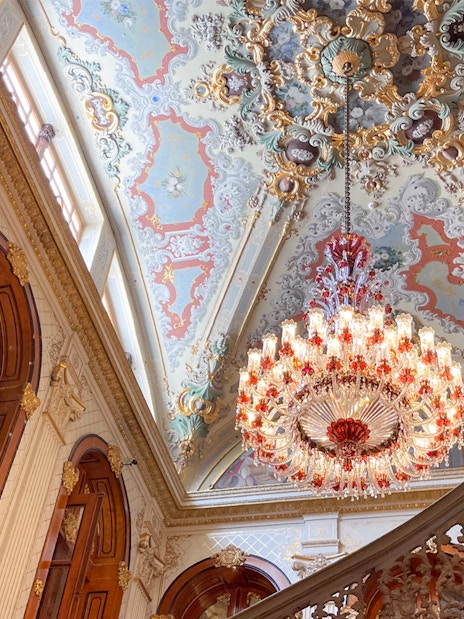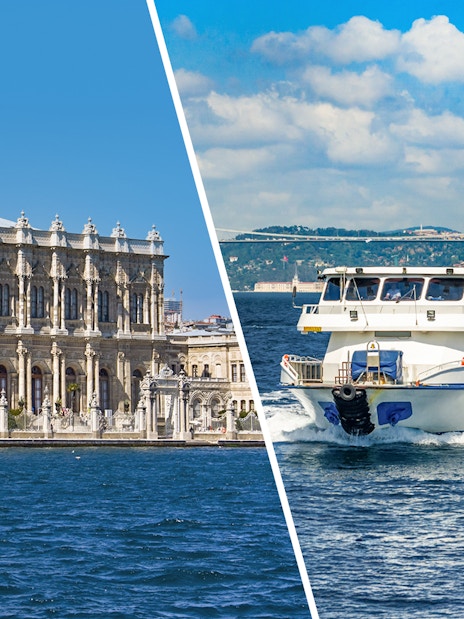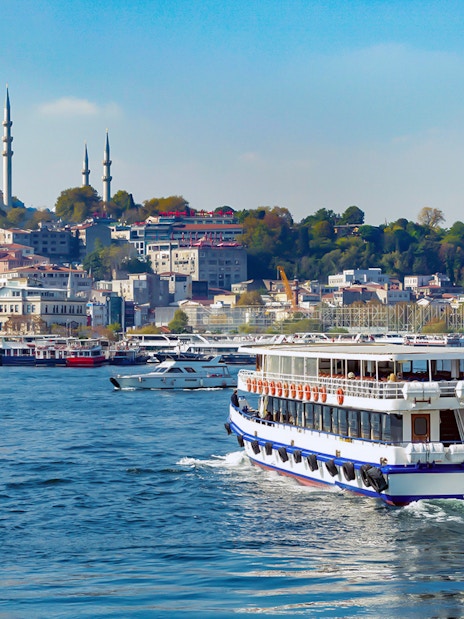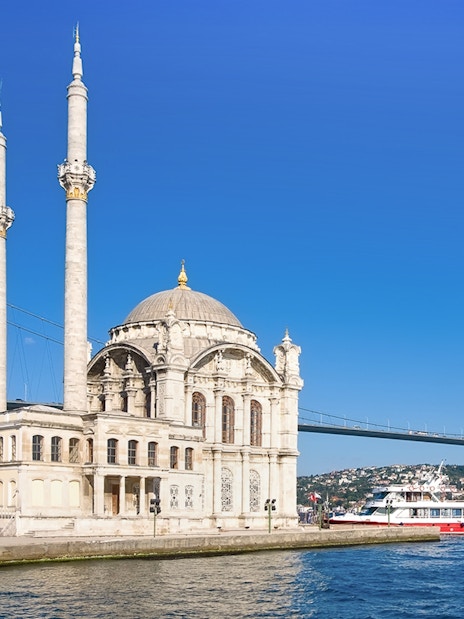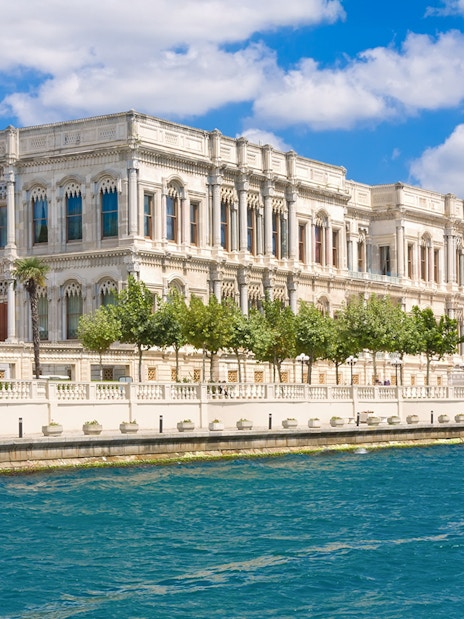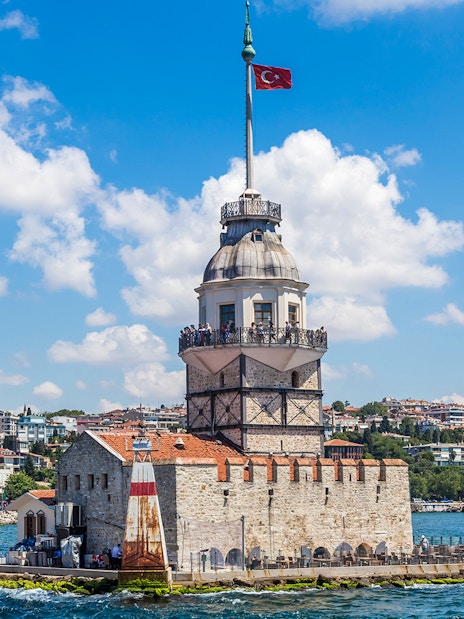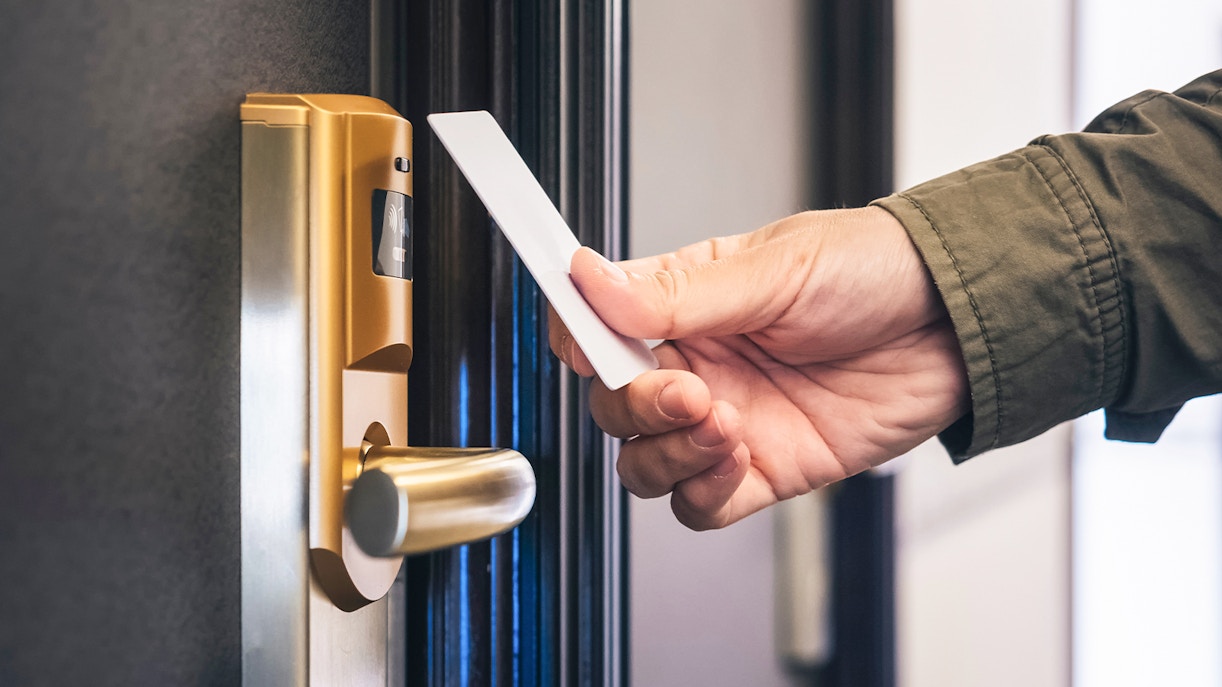- Dolmabahce Palace
- Dolmabahce Museum
- Dolmabahce Clock Tower
- Dolmabahce Palace Harem
- History
- Architecture
- Inside
- Dolmabahce Mosque
- Dolmabahce Palace Garden
Book Dolmabahce Palace Tickets and Tours |

- Enjoy a hassle-free visit to the Dolmabahçe Palace with skip-the-line access and get a glimpse into the glory days of the Ottoman Empire.
- Enter the Medhal Hall, which features Boulle tables on both sides with Sultan Abdülmecid's monogram and the royal monogram over the fireplace.
- Stop by the Tiled room adorned with handmade Turkish rugs, which also houses the palace's largest painting, Surre Alayi.
- Soak in the regality of the Red Room, with hues symbolizing Ottoman power and culture and featuring scenes from Ottoman history and mythology.
- Don't miss the grand crystal chandelier in the Ceremonial Hall. Then check out the Harem, which offers breathtaking views of the Bosphorus.
- Enjoy a hassle-free visit to the Dolmabahçe Palace with skip-the-line access and get a glimpse into the glory days of the Ottoman Empire.
- Enter the Medhal Hall, which features Boulle tables on both sides with Sultan Abdülmecid's monogram and the royal monogram over the fireplace.
- Stop by the Tiled room adorned with handmade Turkish rugs, which also houses the palace's largest painting, Surre Alayi.
- Soak in the regality of the Red Room, with hues symbolizing Ottoman power and culture and featuring scenes from Ottoman history and mythology.
- Don't miss the grand crystal chandelier in the Ceremonial Hall. Then check out the Harem, which offers breathtaking views of the Bosphorus.
Inclusions
- Skip-the-line entry to Dolmabahçe Palace
- Audio guide in 10 languages
- Access to the Harem
Exclusions
- Entry to Clock Museum
- Tip: Complete your visit by enjoying a rich Turkish coffee or tea at the nearby cafes, adding a local flavor to your day.
- Note: Dolmabahçe Palace exclusively issues the audio guide provided with the ticket. The venue does not accept third-party audio guides.
- Visitors must present a valid ID or passport. If neither is available, a €200 deposit may be left at the entrance to obtain an audio guide device. The deposit will be refunded upon the return of the device at the exit.
- Keep your camera tucked away – photography is strictly not allowed at the venue.
- This experience is wheelchair accessible, except for the upper floors.
- Opt for modest attire to respect the site's decorum.
- These tickets can't be cancelled or rescheduled.
Combo (Save 15%): Bosphorus Dinner Cruise with Turkish Show + Dolmabahce Palace Skip-the-Line Tickets
15% off
- Combine a 3-hour Bosphorus cruise and skip-the-line access to Dolmabahce Palace for a budget-friendly adventure, perfect for busy travelers.
- Sail the Bosphorus, savor an authentic mezze platter with fava beans and barbecue, and enjoy unlimited drinks as you soak in Istanbul's beauty.
- See folk dances like the sword and shield dance dating back to pre-Ottoman times as you sail past Ottoman gems like the Rumeli Fortress and the Ortakoy Mosque.
- Explore Dolmabahce at your own pace with an audio guide unlocking the stories behind the handmade Hereke carpets and gold-leaf ceilings.
- Climb the Crystal Staircase, a masterpiece of Baccarat crystal, and visit the Harem section for a glimpse into the Sultan's private world.
- Combine a 3-hour Bosphorus cruise and skip-the-line access to Dolmabahce Palace for a budget-friendly adventure, perfect for busy travelers.
- Sail the Bosphorus, savor an authentic mezze platter with fava beans and barbecue, and enjoy unlimited drinks as you soak in Istanbul's beauty.
- See folk dances like the sword and shield dance dating back to pre-Ottoman times as you sail past Ottoman gems like the Rumeli Fortress and the Ortakoy Mosque.
- Explore Dolmabahce at your own pace with an audio guide unlocking the stories behind the handmade Hereke carpets and gold-leaf ceilings.
- Climb the Crystal Staircase, a masterpiece of Baccarat crystal, and visit the Harem section for a glimpse into the Sultan's private world.
Inclusions
Bosphorus Dinner Cruise
- 3-hour Bosphorus cruise
- 3-course dinner (menu here)
- Unlimited soft drinks
- Turkish night & live entertainment
- Free Wi-Fi on board
- Private & reserved table
Dolmabahce Palace
- Skip-the-line entry to Dolmabahce Palace
- Audio guide in English, German, Russian, Italian, Spanish, French, Polish, Arabic, Chinese, and Turkish
- Entry to Harem section
- Entry to the Painting Museum
Exclusions
Dolmabahce Palace
- Entry to Clock Museum
Bosphorus Dinner Cruise
- Tip: If you crave a quieter moment during the dinner show, head to the bow of the boat to enjoy the Bosphorus breeze and unobstructed views of Istanbul.
- Due to venue restrictions, pets cannot tag along for this experience.
- Dietary needs such as vegetarian, pescetarian, and halal can be accommodated.
Dolmabahce Palace
- Tip: Head towards the balcony at the back of the Muahede Hall for views of the Bosphorus and the Kabatas district.
- These tickets can't be cancelled or rescheduled.
Itinerary
START POINT
Dolmabahçe Clock Tower
The Dolmabahçe Clock Tower, located outside Dolmabahçe Palace in Istanbul, Turkey, was commissioned by Ottoman Sultan Abdülhamid II and designed by the court architect Sarkis Balyan. It was built between 1890 and 1895.
1 minute
1
Dolmabahce Palace
Tickets included
41 minutes
2
END POINT
Dolmabahçe Clock Tower
- Save big with this combo as you explore the brilliant architecture of the Dolmabahce Palace and cruise under the pleasant sun on the Bosphorus Strait.
- Skip the lines at the palace and explore its impressive blend of Ottoman, Baroque, and Neoclassical architectural styles with your English-speaking guide.
- Roam around at your own pace and access the Harem section while listening to your multilingual audioguide.
- Go to the pier for your cruise and enjoy marvelous sights along the European and Asian coastline while tuning in to the audio guide app.
- Enjoy the scenic Bosphorus cruise, passing by Dolmabahce Palace, Ciragan Palace, Ortakoy Mosque, and the Bosphorus Bridge.
- Save big with this combo as you explore the brilliant architecture of the Dolmabahce Palace and cruise under the pleasant sun on the Bosphorus Strait.
- Skip the lines at the palace and explore its impressive blend of Ottoman, Baroque, and Neoclassical architectural styles with your English-speaking guide.
- Roam around at your own pace and access the Harem section while listening to your multilingual audioguide.
- Go to the pier for your cruise and enjoy marvelous sights along the European and Asian coastline while tuning in to the audio guide app.
- Enjoy the scenic Bosphorus cruise, passing by Dolmabahce Palace, Ciragan Palace, Ortakoy Mosque, and the Bosphorus Bridge.
Inclusions
Dolmabahce Palace
- 15-min Dolmabahce Palace Highlights Tour
- English-speaking guide
- Skip the line admission to Dolmabahce Palace
- Access to the Harem section
- Unlimited stay inside the palace
- Audio guide in 15 languages
Bosphorus Cruise
- 75-min cruise on the Bosphorus Strait
- Audio guide app in 9 languages
Exclusions
- Transfer between the palace and the pier
- Tip: April to May and Sept to Nov are the best months to visit Istanbul, the weather is more pleasant, the crowds are thinner and the city is alive with many festivals.
Dolmabahce Palace
- An ID is required to access the free audio guide at the Dolmabahce Palace.
- The Dolmabahce Palace audio guide is available in 15 languages.
- Note that during the winter season (November 1 to March 31), the palace opens around 9am and closes around 4pm.
- Dolmabahce Palace is closed on Mondays.
Bosphorus Crusie
- The audio guide app for the Bosphorus Cruise is only accessible on Android version 10 or later.
- The audio guide is available in 9 languages: English, German, French, Russian, Italian, Polish, Arabic, Chinese, and Turkish.
- You can cancel these tickets up to 24 hours before the experience begins and get a full refund.
Combo (Save 5%): Dolmabahçe Palace Skip-the-Line Tickets with Audio Guide + Hagia Sophia Skip-the-Line Tickets
5% off
- Experience Ottoman splendor and Byzantine heritage with this cost-effective combo that offers skip-the-line access to both Dolmabahçe Palace and Hagia Sophia.
- Step into the royal world of Ottoman sultans at Dolmabahçe Palace, with a multilingual audio guide, and discover the 285-room palace and the royal box.
- Enjoy the palace's opulence as you ascend the crystal staircase to the Ceremonial Hall and explore the vibrant Ottoman culture depicted in the Red Room.
- Journey through time at the Hagia Sophia, which was once the world's largest place of worship, and marvel at its imperial dome and mesmerizing mosaics.
- With skip-the-line access to the 2nd-floor Visitors' Center at Hagia Sophia, explore the UNESCO World Heritage Site at your own pace.
- Experience Ottoman splendor and Byzantine heritage with this cost-effective combo that offers skip-the-line access to both Dolmabahçe Palace and Hagia Sophia.
- Step into the royal world of Ottoman sultans at Dolmabahçe Palace, with a multilingual audio guide, and discover the 285-room palace and the royal box.
- Enjoy the palace's opulence as you ascend the crystal staircase to the Ceremonial Hall and explore the vibrant Ottoman culture depicted in the Red Room.
- Journey through time at the Hagia Sophia, which was once the world's largest place of worship, and marvel at its imperial dome and mesmerizing mosaics.
- With skip-the-line access to the 2nd-floor Visitors' Center at Hagia Sophia, explore the UNESCO World Heritage Site at your own pace.
Inclusions
Dolmabahçe Palace
- Skip-the-line entry to Dolmabahçe Palace
- Audio guide in 10 languages
- Access to the Harem
Hagia Sofia
- Skip the ticket line to Hagia Sophia
- Entry to Hagia Sophia visiting area
- 10% discount at Dsign Cafe
- Downloadable self-guided audio tour in English, Spanish, French, German & Italian
Dolmabahçe Palace
- Tip: Don't forget to explore Imperial Palace, the private quarters of the Sultan’s family, which offer a glimpse into the more personal side of palace life.
- Keep your camera tucked away – photography is strictly not allowed at the venue.
- This experience is wheelchair accessible, except for the upper floors.
- Opt for modest attire to respect the site's decorum.
Hagia Sophia
- Tip: Admire the ornate mihrab as a focal point in the prayer hall, indicating the direction of Mecca.
- You skip the ticket lines but you cannot skip the security check.
- The security check can take up to 60 minutes during peak seasons.
- The prayer area on the first floor can only be entered by Turkish citizens.
- Women are required to cover their knees, shoulders, and chest. Hair should be partially covered with a scarf.
- Men are required to cover their knees and shoulders.
- If you do not have a scarf or body cover, you can buy them at the entrance (A scarf is €2 and a body cover is €3).
- This experience is not accessible by wheelchair and pram/strollers.
- Due to the Friday prayer, the Mosque will be closed to tourists from 12pm to 2pm. For a smoother experience, it's recommend visiting after 4pm to avoid the lengthy security line anticipated between 2pm and 4pm.
- These tickets can't be cancelled or rescheduled.
- With the Istanbul MegaPass, access 2 to 9 attractions in 7 days with Classic, Premium, or Deluxe passes, saving up to 34% on individual ticket costs.
- Head to 2 attractions like the Hagia Sophia, Topkapi Palace, Basilica Cistern, Turkish Hammam, Dolmabahce Palace, and more with the Classic pass.
- What's more? Every pass comes with a free Bosphorus cruise, Blue Mosque tour, transportation card, route maps, and audio guides for all attractions.
- Emails with all tickets to the selected attraction will be delivered straight to your inbox so you can rest assured and plan your adventure.
- Choose the Premium or the all-inclusive Deluxe pass to visit 4 or 9 attractions. More exploration at a great deal!
- With the Istanbul MegaPass, access 2 to 9 attractions in 7 days with Classic, Premium, or Deluxe passes, saving up to 34% on individual ticket costs.
- Head to 2 attractions like the Hagia Sophia, Topkapi Palace, Basilica Cistern, Turkish Hammam, Dolmabahce Palace, and more with the Classic pass.
- What's more? Every pass comes with a free Bosphorus cruise, Blue Mosque tour, transportation card, route maps, and audio guides for all attractions.
- Emails with all tickets to the selected attraction will be delivered straight to your inbox so you can rest assured and plan your adventure.
- Choose the Premium or the all-inclusive Deluxe pass to visit 4 or 9 attractions. More exploration at a great deal!
Inclusions
- Choice of 2/4/9 of Istanbul's top attractions
- Attractions: Hagia Sophia, Topkapi Palace, Basilica Cistern, Dolmabahce Palace
- Cruises: Bosphorus cruise, Dinner cruise on Bosphorus with Turkish drinks and food
- Tours: Asian side walking tour, Blue Mosque tour,
- Access to hop on hop off bus tour
- Activities: Dervish Ceremony, Turkish bath & Hamam
- 5-ride transportation card
- Digital guide book
- City, tram & metro map
- Get the list of included attractions here.
- No reservation is needed for any activity except the Bosphorus Dinner cruise.
- Each pass is valid for 7 consecutive days including the first day of use.
- You can visit multiple attractions in a day but you can only visit each attraction once with this pass.
- You do have skip-the-line access but you will still need to go through security.
- You'll receive tickets for all attractions you have selected in an email, and you'll receive tickets for all attractions if you've chosen the Deluxe pass.
- You can show the PDF digitally on your phone, or get a physical pass printed if you like.
- You can change the chosen attractions as many times as you want, or you can cancel the pass free of charge up to 1 day before the service date.
- You can cancel these tickets up to 24 hours before the experience begins and get a full refund.
Top things to do in Istanbul
Why visit Dolmabahce Palace?

- Largest palace in Turkey: Dolmabahce Palace has 258 rooms and 46 halls and it also happens to be a monoblock building.
- Royal residence of six Sultans: 6 Sultans and a Caliph occupied Dolmabahce Palace, and the palace was the official royal residence from 1856 to its eventual decline in 1924.
- Architectural masterpiece: Dolmabahce Palace was built in a combination of Ottoman as well as Baroque and Rococo architectural styles. It is also traditionally Ottoman in design, with a hall in the middle and rooms surrounding it.
- Structures Of gold: The ceiling of the palace is made of 14 tons of gold, while multiple other palace structures too are decorated with expensive materials.
- Queen Victoria chandelier: One of the most striking objects in Dolmabahce Palace is the beautiful bohemian crystal chandelier which was initially thought to be gifted by Britain’s Queen Victoria.
- Invaluable paintings: Dolmabahce Palace houses hundreds of paintings by Turkish and Western artists, which can be admired by visitors.
Which Dolmabahce Palace ticket is best for you?

If you have limited time
Go for: Skip-the-line tickets
Guide: 15-minute orientation with an English-speaking guide, audio guide in 10 languages
- Skip-the-line tickets allow you to gain direct entry to Dolmabahce Palace so that you can spend time exploring instead of standing in ticket lines. They also provide access to the harem section.
- These tickets include a 15-minute orientation with an English-speaking guide, after which you can explore at your own pace with an audio guide, which is available in 10 languages.
Recommended ticket:

If you are on a budget
Go for: Combo tickets
Guide: English-speaking guide, audio guide
- Combo tickets allow you to cover multiple attractions and experiences with a single ticket, making it easier on your pocket.
- With these tickets, you can enjoy skip-the-line entry to Dolmabahce Palace as well as an informative tour with audio guides in 9 languages.
Recommended tickets:

If you want a comprehensive experience
Go for: Guided tours
Guide: Expert English-speaking tour guide, audio guides
- Explore the lavish Dolmabahce Palace and its trove of historical artifacts in depth with guided tours.
- Gain deep insights into the history of this palace, which was built in the 1800s, with an expert English-speaking tour guide and audio guides in 9 languages.
Recommended ticket:
Cancellation policy: You can cancel these tickets up to 24 hours before the experience begins and get a full refund on your purchase.
Highlights of Dolmabahce Palace

Mabeyn-i Humayun
Ottoman Sultans used Mabeyn-i Humayun to discuss state affairs. The complex contains more than a single floor. The most notable highlight in the hall is a crystal staircase. Visitors can see luxurious decorations, grand chandeliers, carpets, and a Turkish bath at Mabeyn-i Humayun.

Muayede
Muayede is known for being the highest hall and the most significant section of the Dolmabahce Palace. Muayede has a 36-meter-high ceiling supported by 56 columns. The notable attraction in Muayede is the striking crystal chandelier with 750 lamps, weighing over 4.5 tonnes.

Medhal hall
Medhal Hall is considered to be the main hall of Dolmabahce Palace. Visitors today enter the palace through the Medhal Hall. During the Ottoman time, state ministers and administrators occupied the rooms adjacent to the main hall.

Atatürk's room
Mustafa Kemal Atatürk, the first president of the Turkish Republic, spent his last days in Dolmabahce Palace. The bedroom of Atatürk is close to the former harem of the palace. The clock in the room shows the time 9:05 AM paying respect to the president, who died on November 10, 1938.

Red room
The Red Room is close to the main hall or the Medhal Hall. The room got its name from the prominent red color designs in the room. Visitors can see the monogram of Sultan Abdülmecid on top of a Boulle desk. There is another monogram on the fireplace under the dome-shaped roof.

Blue hall
Blue Hall is in the middle of the harem and has distinctive hues of blue. While exploring the Blue Hall, look for the blue shades in decorations, paintings, and marbles. The Blue Hall was used for ceremonial purposes and for Sultans to meet citizens.

Pink hall
The Pink Hall was used for welcoming noble female visitors. It is known as Valide Sultan Divanhanesi in Ottoman times. Sultanas and other royalty used to meet here and spend time together. It has beautiful paintings, and the entire hall is covered with a special rug called Hereke.

Zulvecheyn hall
Zulvecheyn Hall was used as a venue for ceremonies. The hall was constructed as an attachment between the interior and exterior of the palace. It was used for preaching functions, marriages, holidays, and other important public events.

Sufera hall
Sufera Hall, also known as Ambassador Hall, is an exquisite space in the Dolmabahce Palace. Sultans used to meet important people in this room. The Sufera Hall has gold decorations and a collection of stunning bohemian chandeliers.

Harem
Harems are separate quarters built for the leisure of the Royal Family. Harems were a feature of royalty and wealthy families in Middle Eastern traditions. Sultan Abdülmecid built a Dolmabahce Palace harem section to spend time with his children and personal concubines.

Clock tower
The clock tower in Dolmabahce Palace was an addition made in the time of Sultan Abdul Hamid II. Armenian architect Sarkis Balyan designed the neo-baroque-style clock tower that has four sides. The clock was imported from France. Today, the original timepiece is replaced by an electric one.

Dolmabahce mosque
Sultan Abdülmecid’s mother commissioned the Dolmabahce mosque, but the construction of the mosque was completed in 1855. The mosque follows a neo-classical style and has elements of Rococo and Baracoa styles. The palatial decorations of the mosque made it different from the traditional Ottoman Mosque design.

Palace gardens
The gardens of Dolmabahce Palace grow exotic flowers. It also includes typical garden structures, including sculptures, fountains, and pools. The garden complex also has pantries, barracks, animal shelters, an aviary, a glass workshop, etc.

Library
Ottoman emperor Abdülmecid II was the force behind the construction of the library in the palace. It is a huge library in Dolmabahce Palace that has books from the Ottoman and the Ataturk era.

Palace gates
Dolmabahce Palace has eight gates. Three gates open to Bosporus, giving a stunning view of the sea. The gate behind the palace is on the edge of Bosporus Bay, between Asia and Europe. Another important gate is Saltanat Kapisi which opens to the central garden.

Ottoman & European architectural styles
The Ottomans built Dolmabahce Palace to outclass all the other palaces in the region. As Istanbul is a potpourri of cultures, Dolmabahce borrowed from the Baroque, Rococo, and Neoclassical architectural styles. But the architects did not settle for a single technique, and instead infused all these elements of European architecture into traditional Ottoman architecture. While visiting Dolmabahce Palace, the architecture remains a key highlight to admire.
Dolmabahce Palace architecture
Traditional Ottoman decor
In the Dolmabahce Palace decorations, over 100 kilograms of gold and crystal were used. For palace decorations, expensive stones such as Proconnesian marble, Egyptian alabaster, also known as onyx-marble), and Porphyry were used. It houses the largest Bohemian crystal chandelier in the world, weighing over 4.5 tonnes with over 750 lamps. The palace also features numerous Hereke palace carpets made by the Hereke Imperial Factory.
Inside Dolmabahce PalacePlan your visit to Dolmabahce Palace

- Timings:
Tuesday to Sunday: 9 AM to 6 PM
Last entry: 5.30 PM - Closed on: Monday, the First day of the Feast of Sacrifice, the First day of the Ramadan Bairam, and New Year’s Day.
- Duration of visit: 2 to 3 hours
Best time to visit: Dolmabahce Palace is open year-round. The best time of the day to visit is in the morning during the early opening hours to avoid the rush of the crowd. Avoid visiting during monsoon months, July and August, and in the Winter, from December to February, as the weather is not suitable.
Dolmabahce Palace timingsAddress: Dolmabahce Palace, Vişnezade Mahallesi Dolmabahçe Caddesi, Beşiktaş, Istanbul
Getting to Dolmabahce Palace:
- By Tram: T1
Nearest tram stop: Kabataş Tramvay istasyonu - By Bus: 28, 28T, 30D, 22, 22B, DT1, D31, BSK1, BSK2
Nearest bus stop: Kabataş - By Metro: F1 line (Metro’s underground funicular route)
Nearest metro station: Kabataş - By Car: Dolmabahce Palace is located 41.2 km from Istanbul Airport
Nearest parking: Dolmabahce Palace parking, Şeker Otopark, Sinanpaşa Otopark

- Souvenirs: Visitors can buy souvenirs from stores in the Dolmabahce Palace.
- Lost and Found: Dolmabahce Palace has a lost and found service where visitors can report their lost items.
- Wheelchairs: Dolmabahce Palace is wheelchair accessible.

- Book tickets online: Book Dolmabahce Palace tickets online. Dolmabahce Palace is a popular tourist attraction with queues extending hours. Purchasing Dolmabahce Palace tickets online will guarantee your access to the attraction.
- Take scheduled tours: Some sections of the palace are not accessible to tourists. You may be required to sign up for scheduled tours to enjoy it.
- Photography: Visitors are not allowed to take photos inside Dolmabahce Palace.

- Dolmabahce Palace Cafe: For a quick snack or beverage, visitors can head to Dolmabahce Palace Cafe, which is located at the edge of the palace complex and offers amazing views of the palace gardens and the Bosphorus.
- 16 Roof: 16 Roof restaurant offers a range of cuisines from Turkish to Mediterranean, and even Peruvian, giving visitors a wide range of dining options.
- Milli Saraylar Idaresi: Visitors can head to Milli Saraylar Idaresi for a coffee or a quick bite in a pleasant setting.
- Sabrosa Restaurant: Sabrosa Restaurant offers a variety of dishes, including grilled meals, fries, vegan, gluten-free, and brunch.
- Saat Kule Kafeterya: Saat Kule Kafeterya is a Western cafeteria located near Dolmabahce Palace, serving coffee, tea, salads, and desserts.
Explore beyond Dolmabahce Palace

Topkapi Palace
Topkapi Palace is a museum and former administrative center of the Ottoman Empire.
Explore Topkapi Palace
Galata Tower
Galata Tower is a historical museum tower in Istanbul's Galata constructed in 1348 by Byzantine Emperor Justinian.
Explore Galata Tower
Hagia Sophia
Hagia Sophia is a UNESCO World Heritage Site Mosque and former Christian cathedral in Istanbul.
Explore Hagia Sophia
Blue Mosque
A symbol of Turkey's Ottoman rule, the Blue Mosque in Istanbul was constructed in 1723.
Explore Blue MosqueAll your questions about Dolmabahce Palace tickets answered
Dolmabahce Palace tickets are available online. Booking your tickets online helps you save time and get instant confirmation.
Yes, buying Dolmabahce Palace tickets online is convenient and easy. Visitors purchasing tickets online can skip the hour-long queues at the palace.
Dolmabahce Palace tickets start from €29, and prices vary depending on the inclusions and services offered with each ticket.
Yes, booking Dolmabahce Palace tickets online helps you secure amazing deals and discounts on your ticket prices, and you also get to choose from a variety of tickets offering unique facilities and inclusions.
Dolmabahce Palace is the largest palace in Turkey, and it was the administrative center of six Ottoman emperors. It is currently open to the public and can be accessed by visitors by booking tickets.
All visitors need tickets to enter Dolmabahce Palace. Visitors are recommended to book their Dolmabahce Palace tickets online to enjoy hassle-free entry to the attraction.
Dolmabahce Palace is located in the Besiktas district on the European coast of Istanbul. Its address is Vişnezade Mahallesi Dolmabahçe Caddesi, Beşiktaş, Istanbul.
Dolmabahce Palace is an example of a fusion of baroque, rococo, and traditional Turkish architecture. Dolmabahce Palace is known for its historical importance and architectural beauty. It houses the world's largest bohemian crystal chandelier, which is a sight to behold. It is also famous for its beautiful decor, like the details on the floors with real gold.
Dolmabahce Palace is accessible by public transport. You can travel by tram, public bus, or drive to the palace, once you are in the city.
Dolmabahce Palace is open Tuesday to Sunday from 9 AM to 6 PM. The palace is closed on Mondays and certain holidays.
Dolmabahce Palace has souvenir shops, restrooms, lost and found service, and two restaurants on its premises.
Yes, visitors in a wheelchair can access Dolmabahce Palace.
No, Dolmabahce Palace rules do not permit photography inside the property.
Yes, Dolmabahce Palace is worth visiting. Dolmabahce Palace is a world-famous tourist destination in Istanbul. It's the largest palace in Turkey, with gold decorations, bohemian chandeliers, paintings, and rugs.

